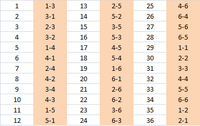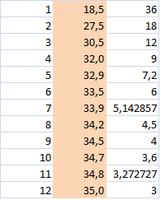I play a 2 dice game with 2 up to 7 players and I just can not figure out what the optimal strategy is. I posted this on a other math forum too a few years ago but so far no one could explain how to play this game optimally. It is a fast and easy game to play, but the math is more difficult than you'd expect. We call it TrickTrack
Rules are as follows:
We decide who can start first (advantage) and then play clockwise if there are more then 2 players. The first player has to throw the 2 dice together to get a score and can decide to throw a 2nd or a third time to get a better score. Last score stands. The players behind, try to better the current score. If all have thrown, the highest scoring player wins and starts next round. If there is a tie, the 2 or more players will throw one more time (or more, if draw again) to decide who won.
Depending on how many times the first player has thrown, the player(s) after him have the same amount of throws to beat his score. If for example the first player throws 3 times and a player after him beats his score with his first throw and decides to stand, then the player(s) after him have only 1 throw each to beat that score. With multiple players, the last player often has to beat a high score with only 1 throw (quite a disadvantage) while the first player(s) can set a score throwing multiple times.
The score is as follows:
With 2 dice you can throw 36 combinations but if the 2 die are different (a three and a two for example) then the highest die goes first, which in this example gives a score of 32. So a two and a six gives a score of 62. A score of 62 will beat 32 because its higher. A double gives a score of 100 times the die, so 2 fives gives 500 which beats 62 and two deuces for 200. The exception is TrickTrack which is the lowest score possible (2 and 1), In this game it beats all other scores and comes right after 6-6 for 600. Making 3-1 the lowest score possible. This basically reduces the total combinations to 21 because of all the doubles.
Question:
Now I try to calculate what the optimal strategy is when I play this against 1 or up to 6 players. It basically comes down to 12 dice combinations (6x2) when to stand after 1 or after 2 throws with 1 or up to 6 players behind me. So that I know if I have to throw a 2nd or third time with x players behind me.
An example of why this is difficult:
If I play against 1 player, I know that with "36" combinations, the average throw is between 5-4 and 6-1. So it is easy to say that if I throw a 5-3, that I have to throw a 2nd time. But the average throw for my 2nd attempt is between 5-4 and 6-1 again, while my opponent then also gets 2 attempts which will increase his chances to throw a higher combination than average. I might have to give up a little after my first throw in order to avoid giving my opponent even better odds when he gets 2 attempts.
The ties also seems to make this quite a difficult puzzle.
Can this be solved?
Rules are as follows:
We decide who can start first (advantage) and then play clockwise if there are more then 2 players. The first player has to throw the 2 dice together to get a score and can decide to throw a 2nd or a third time to get a better score. Last score stands. The players behind, try to better the current score. If all have thrown, the highest scoring player wins and starts next round. If there is a tie, the 2 or more players will throw one more time (or more, if draw again) to decide who won.
Depending on how many times the first player has thrown, the player(s) after him have the same amount of throws to beat his score. If for example the first player throws 3 times and a player after him beats his score with his first throw and decides to stand, then the player(s) after him have only 1 throw each to beat that score. With multiple players, the last player often has to beat a high score with only 1 throw (quite a disadvantage) while the first player(s) can set a score throwing multiple times.
The score is as follows:
With 2 dice you can throw 36 combinations but if the 2 die are different (a three and a two for example) then the highest die goes first, which in this example gives a score of 32. So a two and a six gives a score of 62. A score of 62 will beat 32 because its higher. A double gives a score of 100 times the die, so 2 fives gives 500 which beats 62 and two deuces for 200. The exception is TrickTrack which is the lowest score possible (2 and 1), In this game it beats all other scores and comes right after 6-6 for 600. Making 3-1 the lowest score possible. This basically reduces the total combinations to 21 because of all the doubles.
Question:
Now I try to calculate what the optimal strategy is when I play this against 1 or up to 6 players. It basically comes down to 12 dice combinations (6x2) when to stand after 1 or after 2 throws with 1 or up to 6 players behind me. So that I know if I have to throw a 2nd or third time with x players behind me.
An example of why this is difficult:
If I play against 1 player, I know that with "36" combinations, the average throw is between 5-4 and 6-1. So it is easy to say that if I throw a 5-3, that I have to throw a 2nd time. But the average throw for my 2nd attempt is between 5-4 and 6-1 again, while my opponent then also gets 2 attempts which will increase his chances to throw a higher combination than average. I might have to give up a little after my first throw in order to avoid giving my opponent even better odds when he gets 2 attempts.
The ties also seems to make this quite a difficult puzzle.
Can this be solved?


